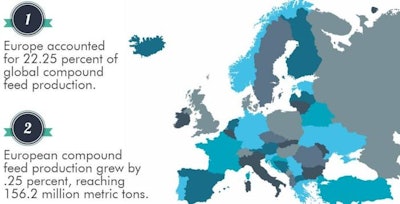

Share this Image On Your Site
Compared with the production growth seen in emerging markets, Europe’s compound feed volumes have remained nearly stagnant in recent years. However, some EU feed-producing companies and farmer cooperatives have grown, either organically or due to acquisitions or expansion beyond their borders.
Of the 101 compound feed manufacturing companies highlighted in the 2015 edition of Feed International’s World’s Top Feed Companies* report, 28 percent hail from Europe. The Top 28 European Feed Companies infographic provides an at-a-glance view of the featured companies and their 2014 production volumes.
In addition to the Top Feed Company data, here are four stats you should know about European livestock feed production.
Four facts about European compound feed production in 2015
- Europe accounted for 22.25 percent of global compound feed production.
- European compound feed production grew by .25 percent, reaching 156.2 million metric tons.
- Europe manufacturers 15 percent of the world’s poultry feed.
- Eight of the top 20 feed-producing countries – which account for 70 percent of world production – are located in Europe.
Much of the data cited above was gleaned from Feed International’s 2015 World Feed Panorama, an exclusive survey that has been charting world feed production since 1990. To view the entire report, visit the April/May 2016 issue of Feed International.
Beyond this infographic, the entire World's Top Feed Companies list can be found in the October/November 2015 digital edition of Feed International magazine. Or, if you wish to conduct a data drill-down by company, you may want to peruse WATT Global Media’s Top Feed Companies database. Here you will find historical content, the number of feed mills, species data — and much more.
*Based on year-end 2014 data
















